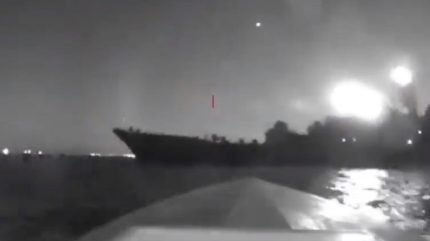
The UK appears to be helping to develop two uncrewed maritime vessels (UMV) for use by Ukrainian forces, which have achieved notable successes against Russian naval assets in the Black Sea through the use of UMVs functioning as one-way attack munitions.
Revealed in a pair of UK parliamentary written responses on 4 February 2025, UK Minister for Defence Procurement, Maria Eagle, made mention of “Wasp” and “Snapper” UMV programmes, which themselves were apparently referenced in an ADS Annual Dinner on 28 January by the UK Secretary of State for Defence, John Healey.

Discover B2B Marketing That Performs
Combine business intelligence and editorial excellence to reach engaged professionals across 36 leading media platforms.
Regarding the Wasp and Snapper UMVs, Eagle said both were “a new uncrewed maritime system” that had been “rapidly developed” specifically to support Ukraine.
“The system is currently undergoing final testing, and further details will be set out in due course,” Eagle stated.
When contacted, the UK Ministry of Defence declined to provide any further details to Naval Technology regarding development of the Wasp and Snapper uncrewed systems.
The revelation of two further military capabilities being developed by the UK for Ukraine followed the announcement – and then subsequent silence – of the Gravehawk air defence system being provided to Kyiv.

US Tariffs are shifting - will you react or anticipate?
Don’t let policy changes catch you off guard. Stay proactive with real-time data and expert analysis.
By GlobalDataHow will UMVs change naval warfare?
In much the same way as smaller, attritable UAS have shifted the balance of power from crewed to uncrewed in the land domain, so too will operations at sea follow.
Analysis conducted by GlobalData predicts that UMVs, both platforms operating on the surface as well as subsurface, will change naval warfare.
Ukraine’s use of naval drones against Russian forces has been a case in point, using rapidly developed surface attack platforms to overwhelm and strike large surface combatants.
In March 2024, Ukrainian leadership forced Russia’s Black Sea Fleet to withdraw from the battlefront after more than one-third of its fleet was seriously damaged or destroyed entirely.
The damage sustained by the Russian Navy, caused in great part by naval drones, has required military leaders across the globe to give additional thought to the way such platforms will alter the future of naval war.
In August 2024, the UK Ministry of Defence stated that Ukraine’s naval defence technology had “proven invaluable” in the Black Sea region, with 26 Russian Navy vessels damaged or destroyed in the region between February 2022 and June 2024.
GlobalData contends that perhaps the most important of all the UMVs deployed in the battlespace has been the Magura V5 USV – a 5.5-metre small-USV (sUSV) weighing less than 1,000kg. The drone has an operational range of up to 800km, a top speed of 78km/h, and is able to accommodate a 200kg explosive payload.
The deputy head of Ukraine’s military intelligence agency, Major-General Vadym Skibitskyi, previously claimed that domestically produced drones were the driving force behind Russia’s withdrawal to the port of Novorossiysk.
During a visit to Ukraine in 2024, Naval Technology spoke with a number of Ukrainian SME’s developing their own UMVs, all following the basic principle of reduced/low-cost platforms that are easy to build at pace and in bulk.



